Joe O’Connell founder of Creative Machines, a collective of artists, engineers and craftsman based in Tucson, Arizona discusses his latest installation in Canada.
The Chinook Arc sculpture is characterized by its location in the historic Beltline neighborhood and colorful playfulness. What inspired this specific location?
Blessing [Hancock] and I visited Calgary when we were selected as finalists for this commission. We always visit a site for a few days to truly understand the environment. We talk to people. We study how we feel as we walk around. In this occasion we experienced what it felt to move between the downtown area and the Beltline neighborhood. A number of people mentioned the Chinook weather phenomena – how a air mass can pop over the mountains and totally change the feel of the city. This conversations resonated with us at that moment – we were thinking about how it felt when that “something” you need comes into your life completely undeserved, un-worked-for, but it is yours nonetheless. Our research was a combination of somewhat disciplined urban analysis and the landscape, combined with the way we as artists are attuned to how physical space influences emotion. The choice of material was partly as a response to how hard edged and opaque much of the architecture in downtown is. We thought it needed something softer, warmer, and more colorful.
What function do you hope the public sculpture serves?
We wanted Chinook Arc to work as a social catalyst. Ducking under and inside the sculpture gives you a view of the sky that is completely free from skyscrapers and construction cranes. There is just the soft undulating horizon formed by the inner edge of the sculpture. The sound quality inside the sculpture totally changes every individual’s experience. For groups the sculpture offers a place to meet, to share videos and to hang out. It becomes a catalyst for impromptu meetings in the neighborhood.

What technological applications were applied in the creation of the piece?
There were two major areas where we pushed the boundaries of public art. The first was structural and this is largely invisible. I’m not aware of a larger acrylic sculpture anywhere in the world – the sheer size introduced complexities that no other sculpture has had to deal with. The compound curves of the outer skin essentially ‘float’ above the steel skeleton on a system of silicone structural bushings that we developed. This allows the two layers of acrylic to slide over each other in response to thermal expansion and contraction. The huge temperature range of Calgary and the difference in thermal coefficients between steel and acrylic meant we needed to decouple the skin from the skeleton. And of course the end result is very strong. The second area of innovation was how to give an illuminated sculpture a strong personality yet leave room for the public to walk up and influence it. We built in hours of programming so that when people is not interacting the piece is going through a variety of slow and fast transitions. We thought about the various vantage points from which people would see the sculpture (up close, from a distance, and from overhead) and developed light programs that evoke aurora borealis, changing seasons, and biological growth. The sculpture goes through hours of such programming every evening, and it never starts with the same sequence. But when people come up to the sculpture, we wanted to give them control over its lighting in a way that was simple and direct yet allowed for great depth. The sensor we developed reacts to people that simply wave their hands in front of it, or wave colored clothing. Another popular way to control the sculpture is by playing a music video on a smartphone. We made a little ledge in front of the sensor and an icon of a smartphone around it to suggest this to people. If you want to take it even further though, you can record your own video with colored objects or with the colors of nature and play this back on the sculpture.
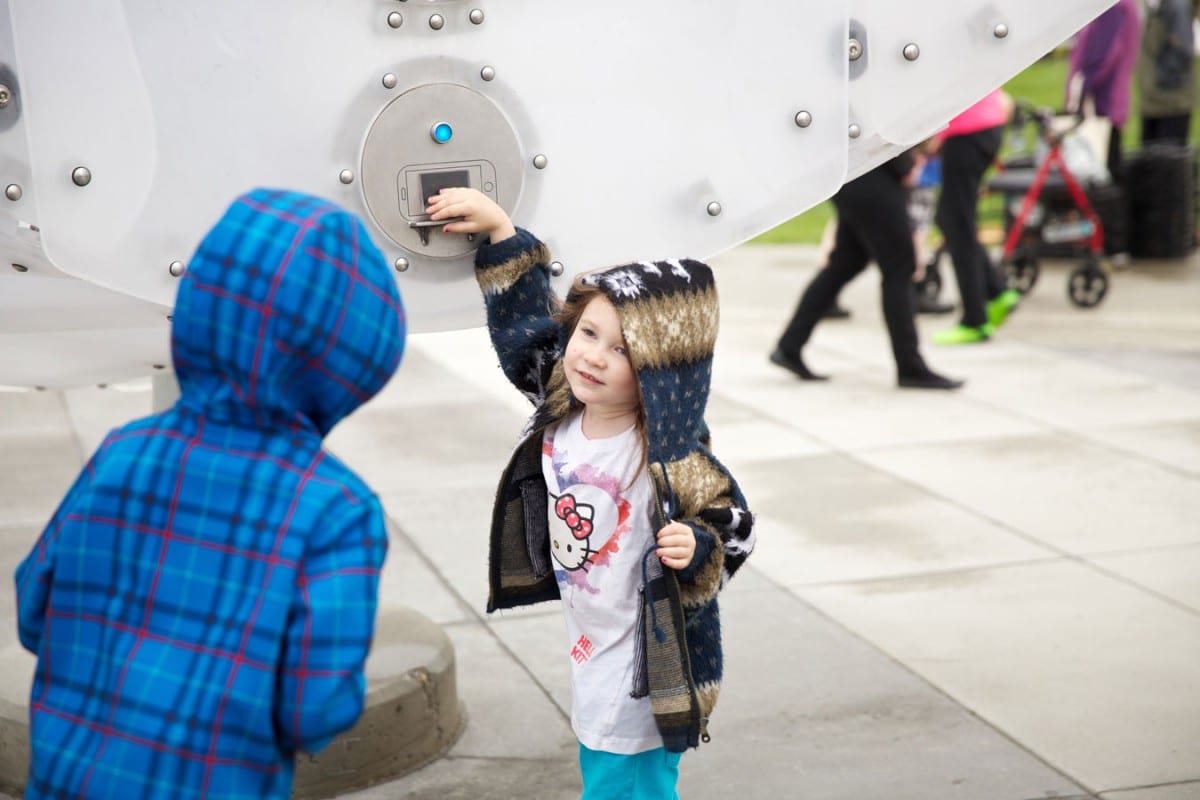
The sculpture’s form represents the history of the location, and its playful environment is reminiscent of the current community. What statement did you hope to achieve with this work?
We definitely responded to the ring-shaped form that is expressed both in the historic streetcar loop that gives the Beltline neighborhood its name and the design of the park with its circular path. The ring is something I explored in my first acrylic sculpture in 2004, but for Chinook Arc Blessing and I refined it with the addition of sharp edges and an undulating form. We also drew on the sharp-edged clouds that sometimes occur as part of the chinook weather phenomenon.

How does the sound of traffic influence the experience of visiting Chinook Arc?
It is definitely meant to be an urban sculpture. We always envisioned people viewing it and visiting it within an urban context. The sound of traffic adds to that. There is a really nice moment that happens when you duck under. You still feel connected to the urban energy around you but the sound level drops considerably and changes in tone making you feel that you are in a special space.
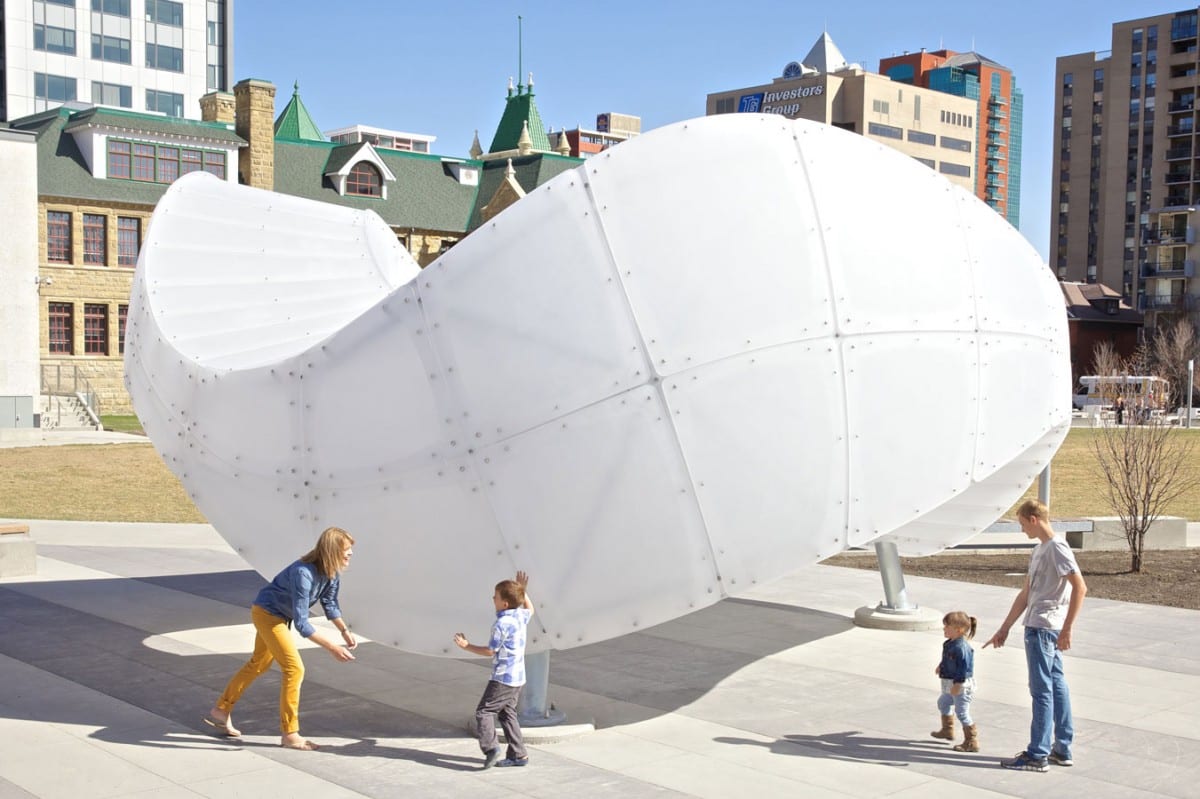
Does the installation have specific hours, or is it always open?
Chinook Arc is always open. Although the LED lighting and the interactive nature have gotten the most attention it is really great to visit in the daytime. The acrylic surface is translucent so you can see the sun shine softly through it, exposing the skeleton inside. It is unusual for a sculpture to reveal its inner structure, Chinook Arc does it day and night in different ways. When it rains, the skin becomes even more transparent to the point where the inner skeleton clearly more visible.
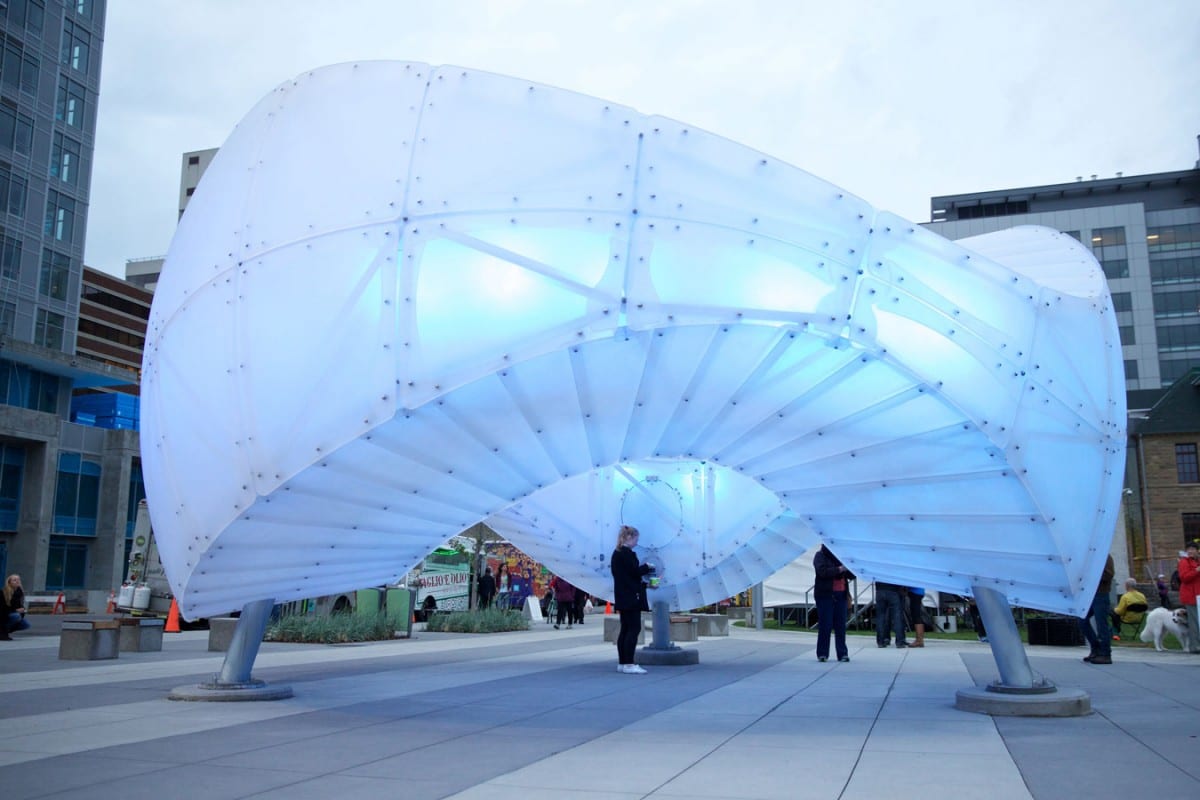
What has the response been from the public?
Everything we have heard has been quite positive. People in the neighborhood have set up a facebook page and twitter account just for Chinook Arc. We like to say that one of our sculptures isn’t complete until people are enjoying it and interacting with it. If it isn’t popular we consider it unsuccessful. I’ve seen people of all ages intrigued and pleased with Chinook Arc. One of my favorite tests for popularity is when complete strangers introduce me to the sculpture as a symbol of pride because it is part of their neighborhood.
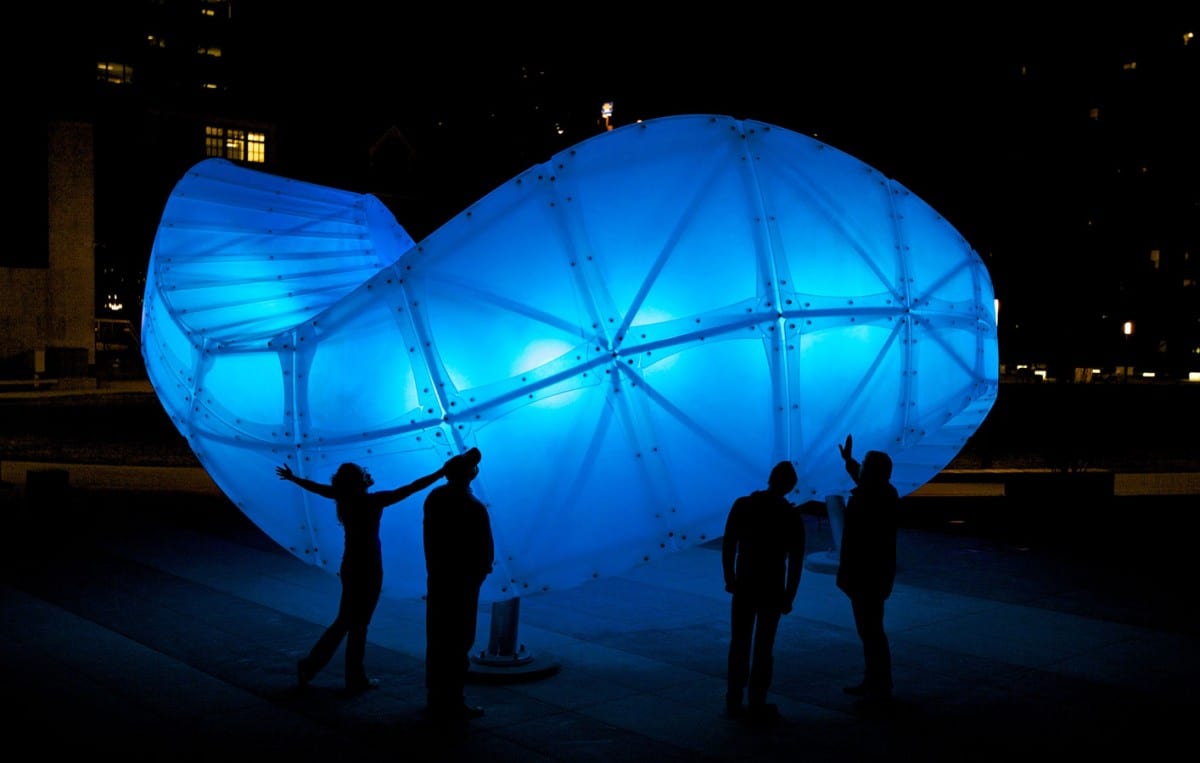
What role did the city of Calgary’s department for culture play in helping you to develop Chinook Arc?
They were with us every step of the way. A selection committee including neighborhood representatives gave us a historical overview of the changes in both the Beltline community and Calgary as a whole. This helped us understand what the neighborhood needed. This project was one of the first to include a substantial Community Cultural Development. This new initiative dovetailed nicely with our own desire to make art for the community usage and to make their own. In order to follow this commitment we commissioned an original musical score by a local composer (Lorna MacLachlan) and her quintet performed as part of the opening event. The city helped us bring in many community groups that made the day-long event very special.

How have your past installations informed your current project?
We spend a lot of time watching what happens in public spaces – both with our own work and others. Seeing – or learning to pay attention to the right things – is at least half of creating good art. This is the third piece we have done with acrylic and about the fifth or sixth interactive piece. Some of the things we’ve learned about interactive public art are: 1) You can’t just put out a blank slate. The art has to come to the site with a strong presence of its own, and offer visitors the chance to contribute in significant ways. 2) You have to allow for both shallow and deep involvement. People have to be able to have a meaningful interaction whether they have just five seconds or five days in which to engage with the piece. That’s why the interactive sensor had to work in a compelling way even if people did something so simple as to wave their hands. 3) Interactivity is more than just buttons and lights. It has to encompass the physical design of the sculpture, paying attention to how people navigate public space, and how the sculpture is sited in the landscape. We learn a little more with each project.
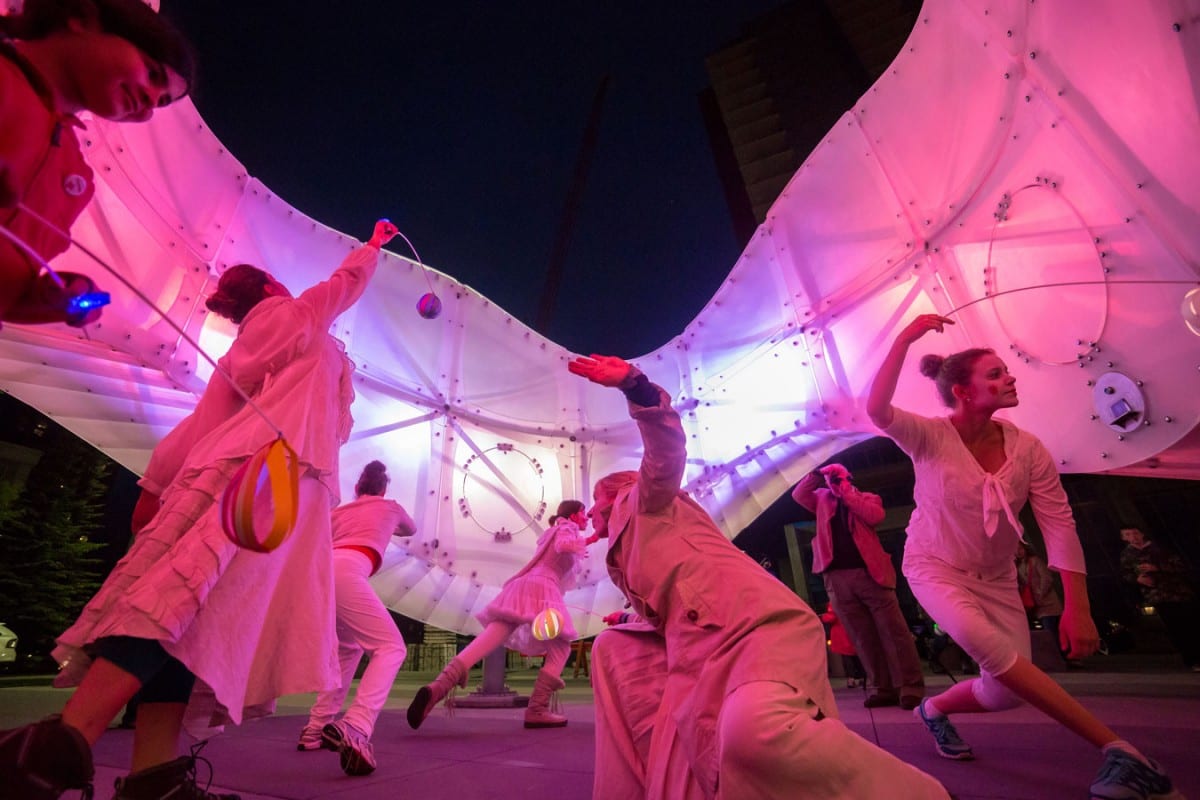
Featured video: Visitors can control the sculpture’s 48 lights through a custom-designed optical sensor. The sensor allows people to change light sequences effectively turning the entire sculpture into a low-resolution screen that reproduces the colors and motion from a cellphone. Also, people can simply wave their hands or hold a colored object up to the sensor to change the lighting. In the video, a visitor transforms the sculpture by playing Britney Spears’ Toxic music video on his phone.
All images © of the artist
Revisit our earlier feature on Creative Machines and their public art project, Ballroom Luminoso.
